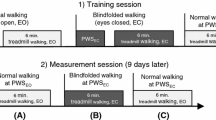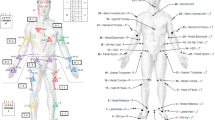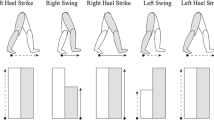Abstract
Healthy persons exhibit relatively small temporal and spatial gait variability when walking unimpeded. In contrast, patients with a sensory deficit (e.g., polyneuropathy) show an increased gait variability that depends on speed and is associated with an increased fall risk. The purpose of this study was to investigate the role of vision in gait stabilization by determining the effects of withdrawing visual information (eyes closed) on gait variability at different locomotion speeds. Ten healthy subjects (32.2 ± 7.9 years, 5 women) walked on a treadmill for 5-min periods at their preferred walking speed and at 20, 40, 70, and 80 % of maximal walking speed during the conditions of walking with eyes open (EO) and with eyes closed (EC). The coefficient of variation (CV) and fractal dimension (α) of the fluctuations in stride time, stride length, and base width were computed and analyzed. Withdrawing visual information increased the base width CV for all walking velocities (p < 0.001). The effects of absent visual information on CV and α of stride time and stride length were most pronounced during slow locomotion (p < 0.001) and declined during fast walking speeds. The results indicate that visual feedback control is used to stabilize the medio-lateral (i.e., base width) gait parameters at all speed sections. In contrast, sensory feedback control in the fore-aft direction (i.e., stride time and stride length) depends on speed. Sensory feedback contributes most to fore-aft gait stabilization during slow locomotion, whereas passive biomechanical mechanisms and an automated central pattern generation appear to control fast locomotion.


Similar content being viewed by others
References
Assaiante C, Marchand AR, Amblard B (1989) Discrete visual samples may control locomotor equilibrium and foot positioning in man. J Mot Behav 21(1):72–91
Bauby CE, Kuo AD (2000) Active control of lateral balance in human walking. J Biomech 33(11):1433–1440
Brandt T (2000) Vestibulopathic gait: you’re better off running than walking. Curr Opin Neurol 13(1):3–5
Brandt T, Strupp M, Benson J (1999) You are better off running than walking with acute vestibulopathy. Lancet 354(9180):746. doi:10.1016/S0140-6736(99)03179-7
Breit GA, Whalen RT (1997) Prediction of human gait parameters from temporal measures of foot-ground contact. Med Sci Sports Exerc 29(4):540–547
Cromwell RL, Newton RA, Forrest G (2002) Influence of vision on head stabilization strategies in older adults during walking. J Gerontol A Biol Sci Med Sci 57(7):M442–M448
Gates DH, Su JL, Dingwell JB (2007) Possible biomechanical origins of the long-range correlations in stride intervals of walking. Phys A 380:259–270. doi:10.1016/j.physa.2007.02.061
Hallemans A, Ortibus E, Meire F, Aerts P (2010) Low vision affects dynamic stability of gait. Gait Posture 32(4):547–551. doi:10.1016/j.gaitpost.2010.07.018
Hausdorff JM (2005) Gait variability: methods, modeling and meaning. J Neuroeng Rehabil 2:19. doi:10.1186/1743-0003-2-19
Hausdorff JM, Peng CK, Ladin Z, Wei JY, Goldberger AL (1995) Is walking a random walk? Evidence for long-range correlations in stride interval of human gait. J Appl Physiol 78(1):349–358
Hausdorff JM, Purdon PL, Peng CK, Ladin Z, Wei JY, Goldberger AL (1996) Fractal dynamics of human gait: stability of long-range correlations in stride interval fluctuations. J Appl Physiol 80(5):1448–1457
Hausdorff JM, Rios DA, Edelberg HK (2001) Gait variability and fall risk in community-living older adults: a 1-year prospective study. Arch Phys Med Rehabil 82(8):1050–1056. doi:10.1053/apmr.2001.24893
Hollands MA, Marple-Horvat DE (1996) Visually guided stepping under conditions of step cycle-related denial of visual information. Exp Brain Res 109(2):343–356
Iosa M, Fusco A, Morone G, Paolucci S (2012) Effects of visual deprivation on gait dynamic stability. ScientificWorldJournal 2012:974560. doi:10.1100/2012/974560
Jahn K, Strupp M, Schneider E, Dieterich M, Brandt T (2001) Visually induced gait deviations during different locomotion speeds. Exp Brain Res 141(3):370–374. doi:10.1007/s002210100884
Jahn K, Deutschlander A, Stephan T, Kalla R, Wiesmann M, Strupp M, Brandt T (2008) Imaging human supraspinal locomotor centers in brainstem and cerebellum. Neuroimage 39(2):786–792. doi:10.1016/j.neuroimage.2007.09.047
Jordan K, Challis JH, Newell KM (2007) Walking speed influences on gait cycle variability. Gait Posture 26(1):128–134. doi:10.1016/j.gaitpost.2006.08.010
Lauk M, Chow CC, Pavlik AE, Collins JJ (1998) Human balance out of equilibrium: nonequilibrium statistical mechanics in posture control. Phys Rev Lett 80(2):413–416
Lipsitz LA (2002) Dynamics of stability: the physiologic basis of functional health and frailty. J Gerontol A Biol Sci Med Sci 57(3):B115–B125
Maki BE (1997) Gait changes in older adults: predictors of falls or indicators of fear. J Am Geriatr Soc 45(3):313–320
Mcgeer T (1990) Passive dynamic walking. Int J Robot Res 9(2):62–82
O’Connor SM, Kuo AD (2009) Direction-dependent control of balance during walking and standing. J Neurophysiol 102(3):1411–1419. doi:10.1152/jn.00131.2009
Patla AE (1997) Understanding the roles of vision in the control of human locomotion. Gait Posture 5(1):54–69. doi:10.1016/s0966-6362(96)01109-5
Patla AE, Goodale MA (1996) Obstacle avoidance during locomotion is unaffected in a patient with visual form agnosia. NeuroReport 8(1):165–168
Pierrynowski MR, Gross A, Miles M, Galea V, McLaughlin L, McPhee C (2005) Reliability of the long-range power-law correlations obtained from the bilateral stride intervals in asymptomatic volunteers whilst treadmill walking. Gait Posture 22(1):46–50. doi:10.1016/j.gaitpost.2004.06.007
Rhea CK, Rietdyk S (2007) Visual exteroceptive information provided during obstacle crossing did not modify the lower limb trajectory. Neurosci Lett 418(1):60–65. doi:10.1016/j.neulet.2007.02.063
Rietdyk S, Rhea CK (2006) Control of adaptive locomotion: effect of visual obstruction and visual cues in the environment. Exp Brain Res 169(2):272–278. doi:10.1007/s00221-005-0345-y
Schniepp R, Wuehr M, Neuhaeusser M, Kamenova M, Dimitriadis K, Klopstock T, Strupp M, Brandt T, Jahn K (2012) Locomotion speed determines gait variability in cerebellar ataxia and vestibular failure. Mov Disord 27(1):125–131. doi:10.1002/mds.23978
Terrier P, Deriaz O (2011) Kinematic variability, fractal dynamics and local dynamic stability of treadmill walking. J Neuroeng Rehabil 8:12. doi:10.1186/1743-0003-8-12
Terrier P, Turner V, Schutz Y (2005) GPS analysis of human locomotion: further evidence for long-range correlations in stride-to-stride fluctuations of gait parameters. Hum Mov Sci 24(1):97–115. doi:10.1016/j.humov.2005.03.002
Warren WH (2009) How do animals get about by vision? Visually controlled locomotion and orientation after 50 years. Br J Psychol 100(Pt 1A):277–281. doi:10.1348/000712609X414150
Winter DA (1983) Biomechanical motor patterns in normal walking. J Mot Behav 15(4):302–330
Wuehr M, Schniepp R, Ilmberger J, Brandt T, Jahn K (2012) Speed-dependent temporospatial gait variability and long-range correlations in cerebellar ataxia. Gait Posture. doi:10.1016/j.gaitpost.2012.07.003
Zarrugh MY, Todd FN, Ralston HJ (1974) Optimization of energy expenditure during level walking. Eur J Appl Physiol Occup Physiol 33(4):293–306
Acknowledgments
The authors thank Judy Benson for copyediting the article. The work was supported by the German Research Foundation (Deutsche Forschungsgemeinschaft, DFG JA1087/1-1) and the German Hertie Foundation and the Federal Ministry for Education and Science (BMBF 01EO0901) of Germany.
Author information
Authors and Affiliations
Corresponding author
Rights and permissions
About this article
Cite this article
Wuehr, M., Schniepp, R., Pradhan, C. et al. Differential effects of absent visual feedback control on gait variability during different locomotion speeds. Exp Brain Res 224, 287–294 (2013). https://doi.org/10.1007/s00221-012-3310-6
Received:
Accepted:
Published:
Issue Date:
DOI: https://doi.org/10.1007/s00221-012-3310-6




